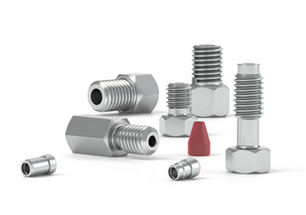Posted by Chrom Tech on 14th Oct 2025
How to Properly Swage HPLC Fittings
Learning how to properly install and tighten HPLC fittings is a key skill for every chromatographer. Whether you’re setting up a new system or performing routine maintenance, you’ll eventually need to adjust or secure a fitting connection. Most HPLC fittings consist of two parts: a nut and a ferrule. The ferrule is typically attached to the tubing through external compression—either by friction for low-pressure fittings or through a permanent attachment process known as swaging for high-pressure connections.
How to Swage a Fitting onto a Piece of Tubing
Swaging creates a strong, leak-free connection by permanently crimping the ferrule onto the tubing. This process is most often used with stainless steel tubing and fittings. The general steps for creating a proper swaged connection are outlined below (as summarized from the IDEX Fittings 101 Guide):
- Slide the nut over the tubing that will be connected.
- Position the ferrule below the nut, ensuring the tapered end faces away from the nut and toward the port.
- Insert the tubing assembly (nut and ferrule in place) into the receiving port until the tubing bottoms out against the stop inside the port.*
- Tighten the nut finger-tight, then use a wrench to turn it an additional ¾ turn to complete the swage. This compression locks the ferrule permanently onto the tubing.
*Note: Some ports do not have a solid internal stop. In those cases, ensure the tubing extends slightly past the ferrule’s nose—but not too far—to avoid improper seating or leaks.
To verify that your swage is properly secured, loosen the nut and remove the fitting. A correctly swaged ferrule will remain fixed on the tubing. If it slides freely, reinsert the tubing and tighten the nut in ¼-turn increments until the ferrule is secure. For UHPLC systems operating at ultra-high pressures, additional tightening may be necessary to achieve a proper seal.
Why Permanently Swage a Fitting to Tubing?
Permanently swaging a ferrule provides a robust, high-pressure seal ideal for demanding chromatography systems. As HPLC systems move toward higher pressure operation, this technique ensures the connection can withstand those pressures without leaking. Additional advantages include:
- Increased reliability: Once swaged, the ferrule and nut assembly won’t loosen or slip off the tubing.
- Higher pressure tolerance: Essential for UHPLC and high-performance solvent delivery systems.
- Reduced risk of lost fittings: Since the ferrule remains attached, it won’t fall off when disconnected from the port.
However, there are a few trade-offs. A swaged fitting can only be used in the original port where it was attached. Because port geometries vary slightly, reusing the fitting elsewhere may result in leaks, dead volume, or alignment issues.
For users who need flexibility or quick changes between connections, Fingertight Fittings offer a convenient alternative. These reusable fittings provide secure connections without the need for tools or permanent swaging. For questions about which fitting type is best for your system, contact Chrom Tech’s support team for expert guidance.
Frequently Asked Questions About Swaging HPLC Fittings
What is swaging in HPLC fittings?
Swaging is the process of permanently attaching a ferrule to stainless steel tubing by tightening the fitting until the ferrule compresses and locks onto the tubing, creating a durable high-pressure seal.
How can I tell if my ferrule is properly swaged?
After tightening, remove the nut and check if the ferrule remains fixed on the tubing. If it slides off, it hasn’t been tightened enough. Retighten in small increments until the ferrule is secure.
Can a swaged fitting be reused in a different port?
No, swaged fittings should only be used in the original port where they were installed. Using them in different ports can cause leaks or dead volume due to minor dimensional differences.

